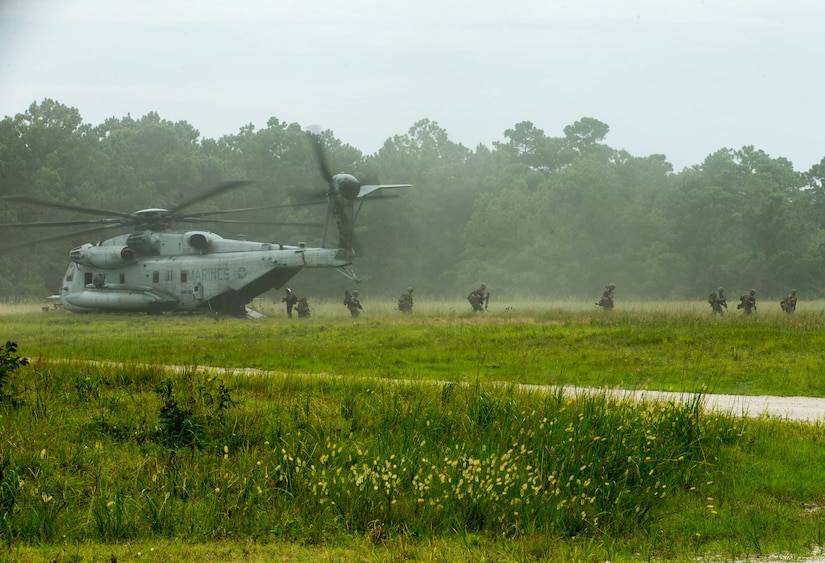

Partnership Aims to Bolster Military Readiness, Protect Environment
August 26, 2020
“The Sentinel Landscape is an idea that has the possibility of uniting people, protecting our ecosystem and enabling our military mission. We can come together on this idea of a secure future.” – Hilary Swain, Archbold Biological Station, Florida
A report released today describes the work done to strengthen military readiness and protect the environment by a partnership that includes the Defense Department, the Agriculture and Interior departments, state and local governments, and nongovernmental organizations.
The Sentinel Landscapes Partnership advances mutually beneficial land-use objectives in areas known as sentinel landscapes. The 2020 Sentinel Landscapes Accomplishment Report provides an overview of the work accomplished thus far.
In April, DOD released a documentary highlighting the seven locations across the country that have been designated as sentinel landscapes. All of them are anchored by at least one high-value military installation or range.
National security is no longer only military readiness, William Jordan Gillis, the assistant secretary of defense for sustainment said recently. It also is food security, water security and environmental security, he explained.
The partnership's overarching goals are to strengthen military readiness, bolster agricultural and forestry productivity, conserve natural resources and increase access to recreational opportunities. It connects private landowners within sentinel landscapes with voluntary government assistance programs that fund land protection or natural resource restoration projects.
The report highlights that through fiscal year 2019, projects across sentinel landscapes have attracted $141 million in DOD funds, $223 million in USDA funds, $41 million in DOI funds, $169 million in state funds, $15 million in local funds and $80 million in private funds. These contributions have permanently protected more than 467,000 acres of land and enrolled 2.3 million acres of land in technical assistance programs.
The report showcases several exceptional projects over the past 12 months. One effort that stands out is within the Georgia Sentinel Landscape, which spans 6 million acres across the eastern portion of the state. In 2019, Georgia Sentinel Landscape partners advanced priorities outlined in the National Defense Strategy by acquiring a conservation easement on an 11,000-acre parcel adjacent to Naval Submarine Base Kings Bay, known as Cabin Bluff.
Before acquisition, the coastal property was zoned for 10,000 homes and 1 million square feet of commercial space. Permanently protecting Cabin Bluff will prevent incompatible development that would have undermined the installation’s ability to deploy nuclear submarines into the Atlantic Ocean, the report said.
The project also increases NSB Kings Bay's resilience to climate change by ensuring that the installation has access to a healthy shoreline. Cabin Bluff encompasses tidal marshes that defend against erosion by absorbing storm surge, flooding and rising sea levels. According to the report, the project will reduce the likelihood that training restrictions triggered by the Endangered Species Act will make NSB Kings Bay's mission more difficult. Cabin Bluff is home to longleaf pine forests that support the gopher tortoise, an at-risk species in Georgia. With proper restoration, the report said, this property can contribute to existing efforts made by DOD to ensure that the gopher tortoise can thrive without regulatory protection. Other sentinel landscape areas include:
- The northern Everglades in Florida, which supports Avon Park Air Force Range. The active training area is 108,214 acres with a sentinel landscape area of 1,672,814 acres.
- Fort Huachuca, Arizona, an active training and testing area of 80,912 acres with a sentinel landscape area of 1,680,895 acres.
- Camp Ripley, Minnesota, an active training area of 52,758 acres with a sentinel landscape area of 719,829 acres.
- Eastern North Carolina, an active training and installation area of 267,913 acres encompassing Fort Bragg, Marine Corps Base Camp Lejeune, Seymour Johnson Air Force Base, Dare County Bombing Range and, Marine Corps Air Stations Cherry Point and New River. The total sentinel landscape is 10,990,233 acres.
- Joint Base Lewis-McChord, Washington, an active training and installation area of 91,322 acres. The total sentinel landscape area is 196,526 acres.
- The middle Chesapeake area, home to Naval Air Station Patuxent River-Atlantic Test Ranges, an area totaling 7,640 acres. The total sentinel landscape area is 2,232,563 acres.
“Through the Sentinel Landscapes Partnership,” Gillis said, “DOD collaborates with its federal partners to streamline funding to projects around high-value military installations that protect against development or environmental conditions that may negatively impact mission capabilities, such as those at ballistic missile and guided missile submarine operations at Naval Submarine Base Kings Bay, [Georgia], testing and research flights at Naval Air Station Patuxent River, [Maryland], and air-to-ground training at Avon Park Air Force Range, [Florida]. “As a result,” he continued, “the partnership allows DOD to cost-effectively enhance its ability to carry out critical testing and training activities in support of the National Defense Strategy.”
Learn More: Sentinel Landscapes Partnership
Learn More: DOD Readiness and Environmental Protection Program
Written by: David Vergun, DoD News
Learn More
Sentinel Landscapes
Conserving land and natural resources, while protecting military training and testing spaces


 Marines with 3rd Battalion, 6th Marine Regiment, 2nd Marine Division, exit a CH-53 Super Stallion helicopter during Exercise Deep Water at Camp Lejeune, N.C., July 29, 2020. Photo By: Marine Corps Cpl. Elijah J. Abernathy
Marines with 3rd Battalion, 6th Marine Regiment, 2nd Marine Division, exit a CH-53 Super Stallion helicopter during Exercise Deep Water at Camp Lejeune, N.C., July 29, 2020. Photo By: Marine Corps Cpl. Elijah J. Abernathy
 Airmen of the 355th Wing respond to a simulated attack during Exercise Bushwhacker 19-08 at Libby Army Airfield, Ariz., Nov. 5, 2019. Photo By: Air Force Senior Airman Mya M. Crosby
Airmen of the 355th Wing respond to a simulated attack during Exercise Bushwhacker 19-08 at Libby Army Airfield, Ariz., Nov. 5, 2019. Photo By: Air Force Senior Airman Mya M. Crosby




